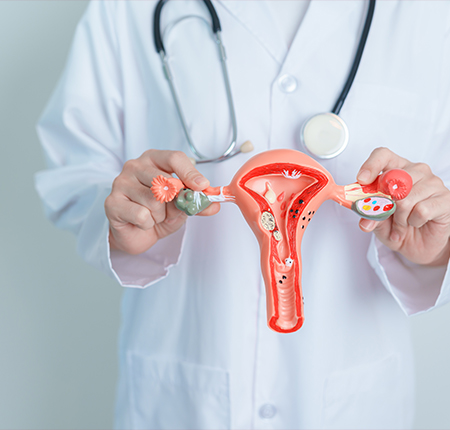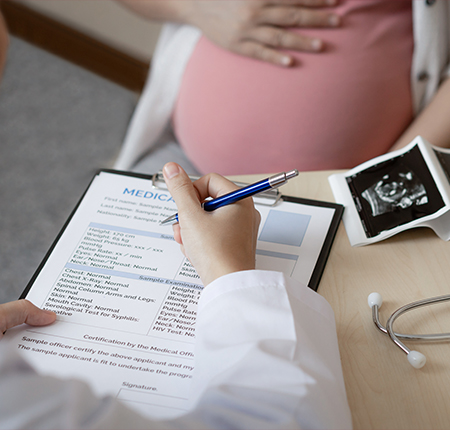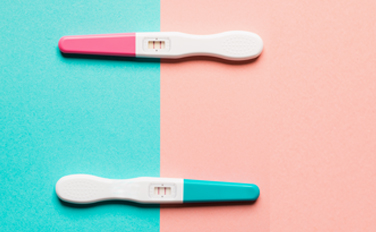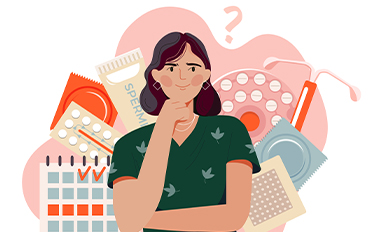
Bleeding in pregnancy - What are they and when do they become a cause for concern?
Light bleeding during pregnancy is normal and does not always hide a problem. According to statistics, 1 in 4 women notices bleeding or spotting at some point during pregnancy, without subsequently suffering a miscarriage. Heavy bleeding, on the other hand, is often dangerous.
That's why it's always good to talk to your doctor about any kind of discharge, so you can rest assured that everything is fine. And because information best prepares you for any challenge, in this article we help you understand what's going on with your body and what to expect when it comes to bleeding during pregnancy.
The difference between bleeding in pregnancy & spotting
During pregnancy, both bleeding and spotting can occur at any time - from implantation to the time of delivery. It is normal, for example, to notice bleeding in the 6th week of pregnancy, as long as it is not as heavy and painful as a period.
To carefully monitor how and how much you bleed, it is recommended that you wear a pad daily throughout your pregnancy. You can best distinguish the two phenomena by watching the amount of blood.
Spotting in pregnancy is only light bleeding - no more than a few drops and certainly not enough to fill a daily pad.
Vaginal bleeding during pregnancy is the opposite - it consists of the loss of a larger amount of blood, with a more abundant flow, for which you need an absorbent so as not to stain your underwear. 
Causes - Bleeding in pregnancy
Spotting and other light pregnancy bleeding are generally not a concern in the first trimester. But the causes behind them are very different, depending on a lot of factors.
What type of pregnancy is it and how advanced is it?
What does the bleeding look like in flow or color?
What other ailments does the pregnant patient suffer from?
From a simple infection or sexual contact, to hormonal changes, ectopic pregnancy or miscarriage, the factors that cause bleeding in pregnancy vary from case to case.
Below we explain in broad terms the most common causes in each trimester of pregnancy, how they manifest and what potential challenges to prepare for if you experience bleeding or spotting during pregnancy.
Causes of bleeding in pregnancy 1st trimester
Light bleeding and discharge during pregnancy 1st trimester are the most normal and common. About 20% of pregnant women bleed during this period, and the causes can be very diverse. Implantation itself, cervical or hormonal changes, various genetic tests on the fetus or other infections can all cause bleeding in the first part of pregnancy.
However, miscarriage and ectopic pregnancy can also be behind bleeding. That's why it's important to let your doctor know about any changes - so they can determine the cause and explain what to do.
Implantation bleeding
Spotting, i.e. light implantation bleeding, can be seen in the first 6 to 12 days after intercourse, as implantation of the fertilized egg takes place. Usually, this type of bleeding in the first month of pregnancy occurs when you would have had your period normally, which is why the two are often confused.
The difference is quite obvious, because this spotting lasts a few hours or at most a few days, and the flow is very low, not being a cause for concern. If instead it lasts more than a few days, or the flow is abundant after a confirmed pregnancy, seek medical help. 
Ectopic / ectopic pregnancy
It is the pregnancy that forms outside the uterus, when the embryo is usually implanted in the fallopian tubes. Such a pregnancy cannot be completed, and its development can endanger the life of the mother.
Bleeding in an ectopic pregnancy usually occurs in the first 12 weeks and is accompanied by abdominal cramps, headaches or severe pain in the pelvic area.
Miscarriage / pregnancy loss
Also during the first 12 weeks of pregnancy, vaginal bleeding can indicate pregnancy loss, respectively a miscarriage. Almost all pregnant women who go through it notice bleeding or spotting before they miscarry, along with abdominal pain and cramping, vaginal discharge of fluid and tissue, or the disappearance of nausea or other pregnancy-specific symptoms. 
Although it is the main cause of concern in pregnancy, in 90% of cases these first trimester bleedings do not actually mean the loss of the fetus, but are normal. This is precisely why it is difficult to identify pregnancy loss - the most obvious symptom is bleeding. Every miscarriage is different and comes with its own symptoms, so it is difficult to recognize it. But the first thing to do, whether you identify or just suspect a miscarriage, is to talk to your doctor.
Hematoma during pregnancy
Bleeding during pregnancy usually stops on its own - that's why it's called self-limiting. But if the abundance is high, they can accumulate and form a clot in the uterine cavity. This blood clot is called a hematoma. Most commonly seen in the first trimester of pregnancy - and rarely in the 2nd and 3rd trimesters - these hematomas can be causes for:
Brown bleeding in pregnancy;
Bright red vaginal bleeding;
Heavy bleeding;
Bleeding with clots during pregnancy.
In most cases, although the hematoma can affect the pregnancy, it is harmless if it occurs in the first 12 weeks. It is easily detected with the help of ultrasound. The specialist doctor can tell what to do after the diagnosis - either a method of preventing pregnancy loss if the bleeding stops and the mother and the fetus are safe, or an emergency caesarean section or induction of vaginal birth
Hematoma cannot be treated, but it can be monitored and managed to protect mother and baby. However, each pregnancy is unique and has specific needs, so each solution will be customized according to the stage of the pregnancy and other factors.
Molar load
It is a very rare situation, a complication that occurs during the conception of the child and that can create serious health problems. Molar pregnancy is actually a benign tumor - so non-cancerous - which manifests itself by the development inside the uterus not of a baby, but of a mass of small vesicles filled with liquid. It is the result of a genetic error, when the sperm and egg do not join properly, which does not allow the embryo to develop.
Bright red to dark brown pregnancy bleeding in the first 3 months of pregnancy are the most prominent symptoms of molar pregnancy, along with pressure or swelling of the abdomen and vaginal discharge of those tiny fluid-filled vesicles that look like a bunch of grapes. The specialist doctor will remove this emergency molar pregnancy, by curettage, in order not to put the mother's life in even greater danger.
Various infections or conditions
Last but not least, lighter or heavier first trimester bleeding and discharge may occur in response to a number of other infections or conditions the mother is suffering from, including:
Vaginal infections (candida infection, bacterial vaginitis);
Sexually transmitted infections (chlamydia, gonorrhea, genital herpes, trichomoniasis), which can cause bleeding by inflammation of the cervix;
Cervical cancer, where painless vaginal bleeding is a common symptom for all women, both pregnant and non-pregnant.

Causes of bleeding in pregnancy 2nd trimester
Starting in the second trimester, the chances of the bleeding being harmless steadily decrease. During this stage - between weeks 14 and 27 - the symptoms specific to pregnancy in the 1st trimester decrease in intensity, whether we are talking about bleeding, fatigue or nausea.
In this context, the probability that abnormal bleeding signals a more serious problem - either of the mother or of the child - increases. It goes without saying that any changes should be reported to the doctor as soon as possible, but let's talk about the most common causes of bleeding that can occur during the 2nd trimester.
Placenta previa
In a normal pregnancy, the placenta develops in the upper part of the uterus, or on one side. But when it grows in the lower part of the uterus, covering part or all of the cervix, it is called placenta praevia and is the cause of heavy vaginal bleeding - bright red and painless - in the second trimester of pregnancy or during labor.
The earlier it is detected, the more likely it is to be resolved. The reverse is true: the more the placenta covers the cervix and spends more months on top of it during pregnancy, the less likely it is to resolve. In this case, the doctor may prohibit sexual contact, the use of a tampon, certain physical exercises such as jogging, jumping or squatting, and finally may recommend cesarean delivery of the baby. 
Placenta abruptio
Another rare complication, which occurs at approx. 1% of pregnant women that can cause bleeding in pregnancy is placenta abruptio. It consists in the partial or total separation of the placenta from the wall of the uterus, thus stopping the supply of oxygen and nutrients from the mother's body to the fetus. In most cases it occurs in the latter part of the 3rd trimester, but it is possible to occur even in the 2nd trimester.
Placenta abruptio can cause severe bleeding - life-threatening for both the baby and the mother - accompanied by uterine contractions and sudden onset of back or abdominal pain. If the blood remains blocked in the uterus, no visible vaginal bleeding occurs. Monitoring is important, and if any type of bleeding occurs, an emergency visit to the doctor will be needed.
Miscarriage
As in the 1st trimester, in the second trimester, or more precisely before the 23rd week of the baby's development, miscarriage can occur, when the pregnancy is suddenly lost or when it stops growing. The cessation of pregnancy in the 2nd trimester may even go unnoticed, and only a specialist consultation can confirm it.
But as a rule, severe abdominal pains and cramps accompany heavy vaginal bleeding, which can be used to recognize a miscarriage. And the cessation of fetal movements, which can be felt as early as the 20th week, is an indication by which we can recognize a miscarriage. Visiting the doctor is the first thing the patient must do when she suffers an abortion, at any stage of pregnancy.
Premature labor or birth
Premature labor and preterm birth are two more situations that can occur in the 2nd trimester anytime after week 20. They can be spontaneous, or they can be induced by a doctor in the event of a complication such as placenta abruptio or praevia, to save life mother and child.
Such spontaneous labor can be recognized by pinkish or red vaginal discharge, increased flow of vaginal bleeding, uterine contractions at regular intervals, menstrual-like pain or pressure in the lower abdomen. As soon as these signs are identified, the mother must urgently visit the doctor.
Cervical problems
A firm, closed opening before pregnancy, the cervix softens throughout pregnancy, dilating and shortening, preparing the mother's body for birth. If it occurs too early, for example in the 2nd trimester of pregnancy, the dilation of the cervix (known as cervical insufficiency or incompetence) or its shortening prevents the normal development of the pregnancy.
These cervical problems can be the cause of vaginal discharge or light bleeding during pregnancy, and can only be diagnosed by a gynecologist. Fortunately, if caught early, the condition can be resolved by cerclage by week 23. It is a surgical procedure to reduce dilation of the cervix to prevent miscarriage or premature birth. 
Uterine rupture
It is a rare complication that threatens the life of the mother and the fetus alike. It can appear as early as the 2nd trimester of pregnancy, but especially in the 3rd trimester, during labor, usually in women who have previously given birth by caesarean section. Uterine rupture is actually the rupture of the uterus along the scar from the caesarean section.
Pains more intense than normal labor pain, abnormal heart rhythm of mother and baby, loss of uterine contractions and vaginal bleeding can all be caused by this uterine rupture. In this case, a new emergency caesarean section is necessary to get rid of the threat to the life of the mother, as well as the fetus.
Vasa previa
Vasa previa can be the cause of very heavy bleeding in pregnancy and poses a great danger to the life of the fetus. It is a rare condition where blood vessels from the umbilical cord or placenta cross the cervical canal (or birth canal). If these fragile blood vessels rupture, the fetus will experience loss of oxygen and severe bleeding, thus putting its life at risk.
Although it is a dangerous abnormality for the baby, it can be managed safely if caught early. With the help of transvaginal ultrasounds, the specialist will periodically assess the risk of the mother going into labor and the size of the cervix, and will be able to plan a cesarean birth to avoid a tragedy.
Causes of bleeding in pregnancy 3rd trimester
From week 28 until week 40, we are talking about the third trimester of pregnancy, or the stage where the baby continues to develop in the womb, taking up more and more space. Vaginal bleeding can occur during the 3rd trimester too - in fact, 1 in 10 women have vaginal bleeding during the 3rd trimester. They can be just as dangerous as in the 2nd trimester, often for the same reasons:
Placenta abruptio - the most common cause of bleeding in the advanced stages of pregnancy;
Sexual contact - usually causes mild, short-lived spotting;
Infection, enlargement, inflammation or failure of the cervix.
Placenta previa;
Vasa praevia;
Uterine rupture;
Miscarriage;
Premature labor or birth.
The important thing to remember here is that it is almost impossible for a mother to distinguish between superficial vaginal bleeding and one that is cause for concern. For this reason, initially, any bleeding has the potential to be dangerous and should be reported to the doctor immediately.
Symptoms & signs associated with bleeding in pregnancy
Although in some cases, vaginal bleeding is painless and harmless, it often comes with other signs when the problems causing it are more serious. Among the symptoms to be aware of and to report to the specialist when they accompany bleeding in pregnancy are:
Pain in the back, abdomen or pelvis;
Cramps similar to those during menstruation;
Fatigue, nausea, headache, dizziness;
Cessation of fetal movements;
Removal of fluid, tissue or any other abnormal vaginal discharge;
Fever;
Uterine contractions;
Uterine pressure or tenderness.
Bleeding in pregnancy after intercourse
No, most of the time they are not a cause for concern. The cervix is constantly changing during pregnancy, and its sensitivity increases. Therefore, a small amount of short-term vaginal bleeding, pink, light red or even brown in color, is normal after sexual intercourse or even after a gynecological examination. Especially in the first months of pregnancy.
They only become a cause for concern if they last more than a few days, have a heavy flow, or are accompanied by abdominal pain, pressure, or contractions.
When should you go to the doctor if you are bleeding during pregnancy?
Without a medical examination, it is impossible for the patient to know when a bleeding in pregnancy is harmless, and when it threatens the pregnancy, the baby or the mother. It is good to inform your doctor about any type of bleeding or change in vaginal discharge. 
Also, if the bleeding suddenly becomes profuse, lasts for several days, or is accompanied by other symptoms, an emergency visit to the hospital is necessary for more investigations.
Diagnosis of bleeding in pregnancy
The diagnosis can only be made by the gynecologist, where it is recommended to go as soon as you notice the appearance or change of bleeding during pregnancy. To find out what causes them, the doctor can use several tests:
Pelvic gynecological examination;
Vaginal gynecological examination;
Blood tests to check hormonal balance;
Testing using ultrasound technology;
Transvaginal ultrasound.
Monitoring and management of bleeding can be done at home if the symptoms are not severe and do not endanger the life of the mother and the fetus. Otherwise, the patient is hospitalized and kept under observation.
How is bleeding during pregnancy treated?
Treatment differs from one patient to another, depending on the cause of the bleeding, the stage of pregnancy and the health of the mother. Rest is almost always recommended, along with:
Periodic monitoring and testing;
Prohibition of vaginal douches, tampons and sexual contact;
Various medicines, depending on the case;
The suggestion to leave work and stay at home;
Hospitalization;
Surgical intervention.
It is essential to follow your doctor's advice and attend all scheduled tests and appointments to keep your life - and your baby's - safe.
Untreated Bleeding in Pregnancy - Complications
Bleeding in pregnancy should not be ignored or left untreated under any circumstances. They can lead to the most tragic complications, from miscarriage and the death of the baby, to heavy bleeding, hemorrhages and serious health problems for the mother.
Recommendations - What can you do at home if you have vaginal bleeding during pregnancy?
The first and most important thing is to visit the gynecologist or the hospital. No more than 2 weeks when you would normally have your appointment. Not for a few days. But urgently. Vaginal bleeding can be life-threatening to you and the fetus, and should be addressed as soon as possible.
Apart from this essential aspect and carefully following the recommendations and treatment prescribed by the doctor, here are other things you can do at home in case of bleeding during pregnancy:
Reduces the intensity of physical exertion: avoiding jumping, squatting and running are often recommended in this case. Also, if you practice a sport, reduce its intensity and prioritize your rest;
Wear organic pads: Watch the color and flow of your bleeding for any changes, using a daily if you have light spotting/leaking or a normal pad if the bleeding is heavy. Take care of your and your baby's health by using organic, non-toxic and hypoallergenic menstrual products made from 100% organic cotton and without hidden ingredients that are harmful to you and your pregnancy.

Choose a balanced diet: with or without bleeding, nutrition is important during pregnancy for the health of the mother and the fetus. Make sure you have enough sources of fiber and protein, but also carbohydrates and fats, including as varied foods as possible in your diet.
Avoid smoking: Studies show that smoking doubles the chances of abnormal bleeding during pregnancy, while also increasing the risk of fetal problems. It is a harmful habit that is recommended to be avoided during pregnancy.
General questions
Any type of bleeding can raise dozens of questions. We encourage you to confidently address all of them to the specialist doctor, who is best able to answer you, but also to offer you the solutions to protect the baby's life and yours. Below, we've answered the most frequently asked questions about pregnancy bleeding in order to prepare you for the eventuality that you experience them yourself.
Does pregnancy bleeding automatically mean pregnancy loss?
No, and even less in the first trimester of pregnancy, when they are normal and can appear without any impact on the development of the pregnancy. However, if you have menstrual-like bleeding during pregnancy or any other worrisome changes/symptoms, you should see a doctor immediately.
At the same time, it is good to inform your doctor whether you have pink discharge during pregnancy that seems trivial, or more abundant discharge. This way you can eliminate the reasons for concern, and the specialist can prepare a management and monitoring plan in time to avoid pregnancy loss.
How many days after pregnancy does bleeding occur?
Bleeding in pregnancy can occur at any stage and in any trimester, depending on the causes. But if we talk about implantation bleeding, it can occur anytime during the first 6 to 12 days of conception and pregnancy.
How long does implantation bleeding last?
Also known as nidation bleeding, this is mild and short-lived. Spotting lasts from a few hours to a few days, and stops on its own.
Hi!
an ENROUSH account.
Let's create a new account for you!
You're almost there. Choose the checkout method:
Shopping Cart
{{ line.unit_price }} {{ line.product.currency }} / unit per billing cycle
VAT included
-
Subtotal{{ formatPrice(model.cart.total_price) }} {{ model.cart.lines[0].product.currency }}
VAT included






















